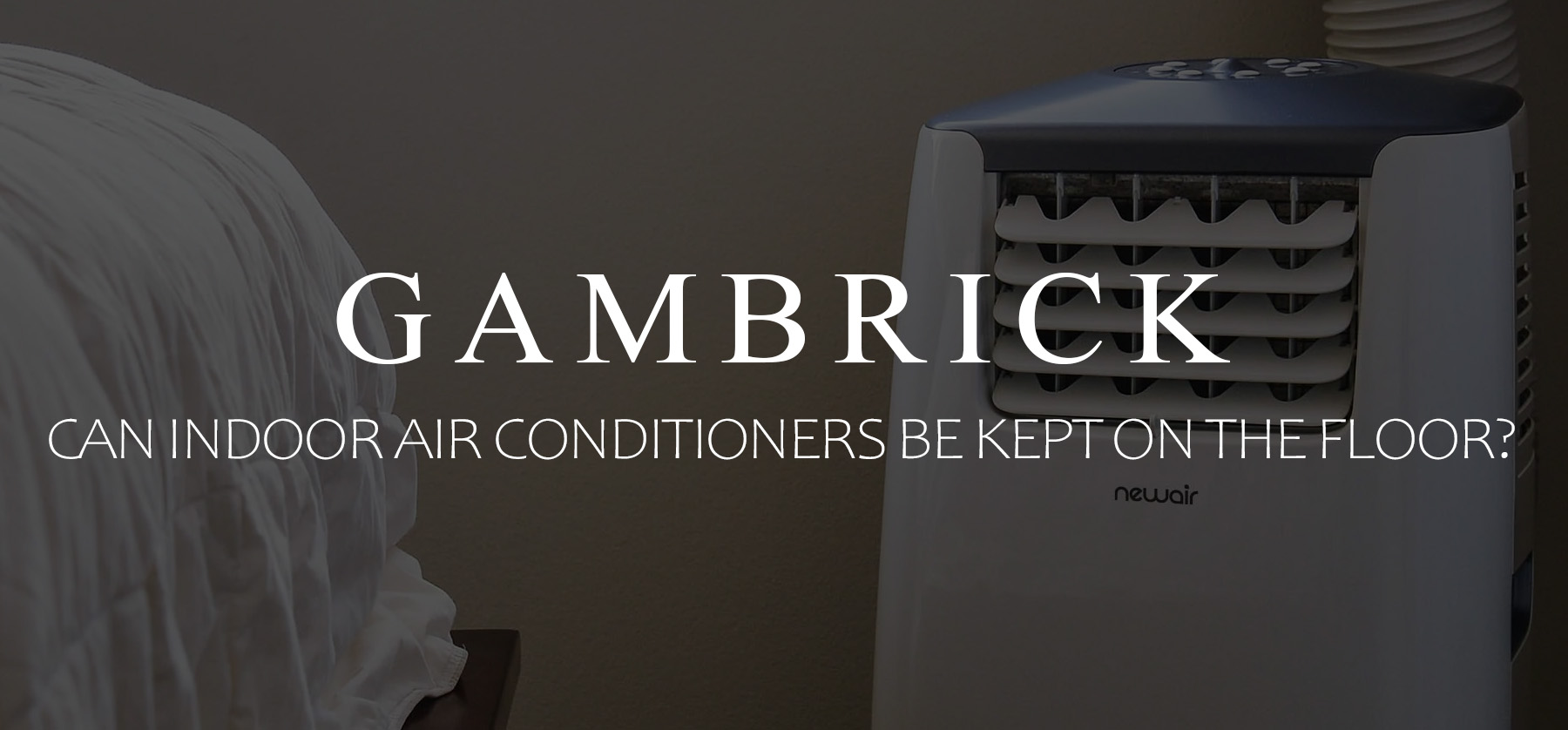Can Indoor Air Conditioners Be Kept On The Floor?
Indoor air conditioners can be kept on the floor if you vent them to the outside and have a way for them to drain, but they won’t be as efficient. Air conditioners take in warm fresh air and turn it into cool air by drawing out the heat. There are two byproducts of this process, heat and moisture. If you run an air conditioner on the floor you need a plan to deal with both of these issues.
- First, all air conditioners need to vent the hot air created when the A.C. makes cool air. Without the vent your air conditioner will simultaneously fill the room with both hot and cool air.
- Second, when air is cooled inside the A.C. it produces moisture. If you don’t have a plan to collect or drain water out of the room your A.C. will create pools of water all over the floor.
While it’s possible to run an A.C. unit on the floor, it won’t be as efficient. Hot air rises and cool air sinks. If you place an A.C. unit on the floor it will suck in cool air instead of warm air. This makes the unit work harder and run longer because the air it takes in is already cool.
Dust also falls lower to the ground because it’s heavier than air. When you run an A.C. unit on the floor the filters don’t last as long because they suck in more dust.
Running an indoor A.C on the floor is definitely possible, but it’s less efficient and you’ll need a plan to both vent and drain the unit. In this article we’ll explain how.
Why Are Air Conditioners Not Installed On The Floor?
Air conditioners are generally not installed on the floor because cold air sinks as hot air rises. If an A.C. unit is placed near the floor, cool air would be recycled at the bottom and the room would not be cooled effectively. In order for an A.C to work efficiently it needs to draw in warm air and expel cool air. To do this it needs to sit higher off the floor where the warm air is.
A.C. units work based a heat exchange principle following these simple steps:
- Warm air is drawn into the unit
- Heat is extracted from the air by the refrigerant in the A.C.
- Cool air is blown into the room by fans inside the A.C. while hot air is vented out.
By replacing warm air with cool air the room’s temperature will eventually drop. But if the A.C. is drawing in cool air instead of hot, it’s much hard to cool the room because it’s simply recycling air that’s already been cooled.
For an A.C. unit to work its best, it needs to draw in warm air. This is why most A.C. units are installed higher in the room.
Luckily an A.C. unit will still work when sitting on the floor. It just won’t be as efficient.
If you want to make a ground level A.C. work more efficiently, combine it with a ceiling fan. A ceiling fan will circulate the air and push warm air down towards the floor. The A.C. unit sitting on the floor will then suck it in and make it cooler.
The Downside Of Running An A.C. Unit On The Floor
Running an indoor air conditioner on the floor is inefficient and stresses the unit. The A.C. needs to work harder for longer to sufficiently cool the air in the room which stresses its mechanical parts. This is why window A.C. units generally last a lot longer than floor models.
- The compressor is the part that works the hardest and is the first part that generally breaks in a floor unit. It can be repaired but A.C. compressors are expensive to repair and replace.
- Floor A.C. units work better when combined with a ceiling fan that circulates warm air. But you need a ceiling fan in the room. Without one they’re just recycling cool air.
- Cooling warm air creates a lot of moisture. Without a way for the unit to drain you’ll get water all over the floor.
- Dust is heavy which is why low air is generally dustier than high air. When you run an A.C. on the floor it usually collects a lot more dust which can quickly clog the filter.
- Furniture is down low where a ground level A.C. unit is so you have to be careful about where you place it.
There are challenges to overcome when sitting an A.C. unit on the floor, but it can definitely be done if you have a plan in place. The most important thing is venting the unit and dealing with water. Once that’s done, you can run a fan to circulate hot air and think about where the best location is for the unit.
Make sure to position the A.C. on an exterior wall near a window so you can properly vent it.
Floor Air Conditioners Clog More Often
Air conditioners that are sitting on the floor have to deal with more dust than high or window A.C. units. Dust is heavier than air and eventually works it’s way down to the floor. This is made worse when air circulates because it also moves the dust which eventually falls to the ground.
A.C. units have a filter system which collects dust as it passes through the unit. When filters becomes clogged it blocks the flow of air and restricts the unit. This not only makes them less efficient but also strains the motor.
When an A.C. filters air it helps the unit cool the air more effectively and improves air quality by taking dust, allergens and particulates out of the room.
When air conditioners are placed on the floor they collect more dust and clog up faster. A clogged filter will restrict air flow and stain the motor. This will reduce the units efficiency and could eventually damage the motor.
Make sure you keep the filter clean and have a replacement ready. If you notice the A.C. isn’t blowing as cold as it used to, the most likely cause is a clogged filter.
Furniture Is An Issue For Ground Level A.C. Units
Air conditioners sitting on the floor have to deal with obstacles in its way like furniture.Tables, chairs, desks, beds, book cases and other large pieces of furniture can all block the units air flow. Anything in the direct path of the unit can black air which prevents the A.C. from cooling the room.
Furniture in the way of air flow can create pockets of hot and cool air throughout the room. This is an issue because in some rooms you have to sit right next to the A.C. to get any cool air.
As the A.C. unit sucks in warm air and blows out cool air, it circulates the air within the room. If large furniture blocks the flow of air the A.C. won;t work as efficiently.
AC units installed high up are above obstacles so the airflow is unimpeded. This allows the air to circulate throughout the room as it falls to the ground.
If you’re using an air conditioner on the floor try to position it away from large furniture that can block its airflow. You can also install a fan to help circulate cool air around the room. Just make sure to keep the A.C. near a window so you can vent it properly.
Can An Indoor Air Conditioner Sit On The Floor?
Yes, an indoor air conditioner can sit on the floor. However they are not as efficient as high or window A.C. units. Because cool air falls, floor level A.C. units have to work harder because they end up recycling cool air rather than drawing in warm air and making it cool which is what they’re designed to do. The ground level is also dustier which clogs the unit faster and they need a place to vent and drain.
Despite some challenges and drawbacks, an A.C. unit can definitely be used on the floor and there are some things you can do to make them more efficient.
- Make sure the unit is by an exterior window or door so you can vent and drain it properly. If you don’t vent the unit you’ll simultaneously be cooling and heating the room.
- If the A.C doesn’t have a drain tube place it in a drain pan to collect the water.
- Place the unit on a piece of furniture to elevate it higher. The higher it is the more efficient an A.C. becomes.
- Don’t position large furniture in front of the unit because it will obstruct air flow.
- Use a floor fan along with the A.C. to circulate air around the room.
- A ceiling fan will push warm air down to the A.C. so it can cool it.
- Have a spare filter on hand because they clog faster when an A.C. is on the floor.
If you do some or all of these things you can get good results from a floor level air conditioner.
Floor A.C. Model Design Is Improving
A traditional floor or window A.C. unit draws air in from the front of the unit through a filter, cools it and then blows it out through vents which are also located in the front. Typically the hot air is exhausted out the back which is through a hose or out a window. But newer models are designed to blow air out the top of the unit rather than the front. This is a better design when you sit the A.C. on the floor because it helps circulate air up high instead of towards furniture or other obstacles.
When an A.C. blows air up it also displaces and circulates the air above it. This forces warmer air down and into the unit. High air can circulate above obstacles and move freely throughout the room. Then it falls down where the people are. This is a much better design.
A vertical blower is a better design when the A.C. is siting on the floor.
If you’re shopping for a floor A.C. unit look for a model with a vertical blower. They’re better at cooling a room than old fashioned designs.
One way you can make a floor A.C. unit more efficient is to elevate it slightly. Place it on some furniture like a chair or small end table. The higher up you sit it the more efficient it becomes because eventually whatever cool air it pumps will fall down to ground level.
Can You Use An A.C. Without A Window?
Yes, an indoor air conditioner requires a place to vent it, but it doesn’t have to be a window. You can vent an A.C. unit out a door or other vent in your house like a chimney flu. As long as the hot air produced by the A.C. is pumped out of the room the unit will work fine.
The next issue with indoor A.C. units is that they produce a lot of water when they extract the heat out of warm air. Some floor units have a bucket built in which collects the water while others have a drain hose. If you’re unit has a drain hose you need to run it into a house drain, the outside or into a bucket.
If you’re using an A.C. unit on the floor that doesn’t have a drain hose or internal bucket, such as a window unit, place it in a drain pan. The pan will collect the water that leaks out of the A.C.
Can You Use A Window Air Conditioner On The Floor?
Yes, a window air conditioner will still work if it’s placed on the floor, however it’s not recommended and you still have to both vent and drain it. The entire back end of a window air conditioner is a large vent which exhausts hot air out the window. If you sit the unit on the floor it will pump hot air into the room as it blows cool air from the front vents. This is a bad idea so you have to get that hot air vented outside. Some sheet metal or insulated ducts will work fine if you have some.
The next problem with running a window A.C. on the floor is drainage. A.C. units produce water when they extract the heat out of warm air. Since window units don’t have a drain hose you’ll have to collect the water in a pan. Place the unit in a drain pan with a small pump that send water outside, into a house drain or a collection bucket.
Do not run a window A.C. on the floor without venting and draining it.
Make sure you keep the unit level and upright as if it were sitting in a window sill.
Running a window A.C. inside the room will likely cause it lose efficiency. Make sure you vent it properly. If you restrict the units air flow it could strain the motor.
Air conditioners work best when they’re elevated. Cold air sinks so floor A.C. units eventually recycle cool air rather than cooling hot air. To fix this, place the unit on a table. This helps draw in warmer air which is higher up in the room.
Combine a floor A.C. unit with a floor or ceiling fan to help circulate cool air and draw warm fresh air into the A.C.
Summary: Can Indoor Air Conditioners Be Kept On The Floor?
Indoor air conditioners can be kept on the floor if you vent them to the outside and have a way for them to drain, but they won’t be as efficient. Air conditioners take in warm fresh air and turn it into cool air by drawing out the heat. There are two byproducts of this process, heat and moisture. If you run an air conditioner on the floor you need a plan to deal with both of these issues.
- First, all air conditioners need to vent the hot air created when the A.C. makes cool air. Without the vent your air conditioner will simultaneously fill the room with both hot and cool air.
- Second, when air is cooled inside the A.C. it produces moisture. If you don’t have a plan to collect or drain water out of the room your A.C. will create pools of water all over the floor.
While it’s possible to run an A.C. unit on the floor, it won’t be as efficient. Hot air rises and cool air sinks. If you place an A.C. unit on the floor it will suck in cool air instead of warm air. This makes the unit work harder and run longer because the air it takes in is already cool.
Dust also falls lower to the ground because it’s heavier than air. When you run an A.C. unit on the floor the filters don’t last as long because they suck in more dust.
Running an indoor A.C on the floor is definitely possible, but it’s less efficient and you’ll need a plan to both vent and drain the unit.
If you have any questions or comments about running an indoor A.C. unit on the floor email any time.






















